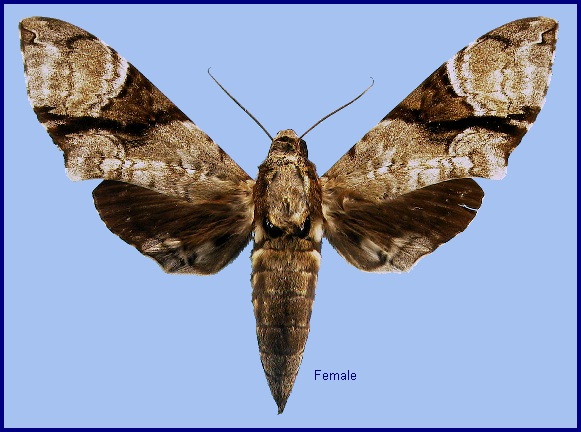
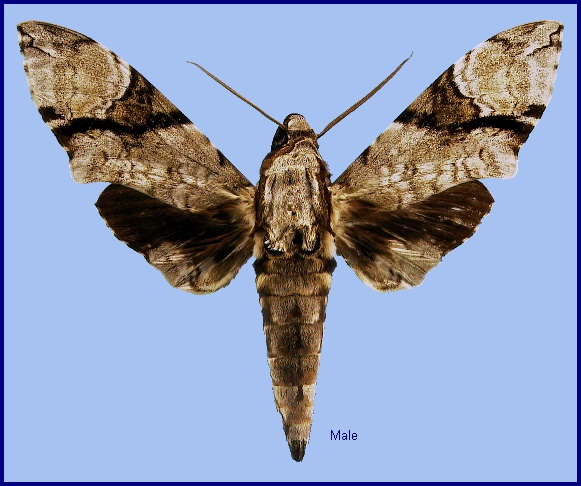
Macrosila obliqua Walker, 1856, List Specimens lepid. Insects Colln Br. Mus. 8: 208. Type locality: Ceylon [Sri Lanka].
Synonym. Macrosila obliqua Walker, 1856.
Synonym. Sphinx nestor Boisduval, 1875.
Synonym. Diludia obliqua Butler, 1877.
Wingspan: 120--145mm. Although confused with Psilogramma menephron by Hampson and some other authors in the past, difficult to confuse with any other sphingid -- the combination of the labial palp structure, long thorax and wing pattern is unique. Proboscis much longer than body. Labial palp distinctive: segment two triangular, much shorter than segment one; apex of segment one with large cavity. Thorax very long, extending far beyond base of forewing. Forecoxa with conspicuous hair pencil. Mid- and hindbasitarsal combs present, conspicuous. Pulvillus with two lobes. Arolium present.
In the male genitalia, tergite A8 with an apical row of elongate, tawny stridulatory scales, these angled inside but not forming a ribbon (as in Ambulycini and some Smerinthini). Uncus resembling that of Agrius convolvuli in dorsal view but more slender in lateral view, gradually tapering to a point. Gnathos with a broadly rounded median lobe, convex below. Harpe with a broad, upwardly recurved dorsal hook; ventro-apical hook of other Acherontiini replaced by a series of multiple hooks along entire distal margin. Valve with large patch of multidentate stridulatory scales. Phallus broad, lacking terminal processes. In the female genitalia, antevaginal plate membranous and folded proximally. Anterior margin of ostium bursae formed into a truncate, feebly sinuate lip with prominent angles. Postvaginal plate more strongly sclerotized, smooth, short.
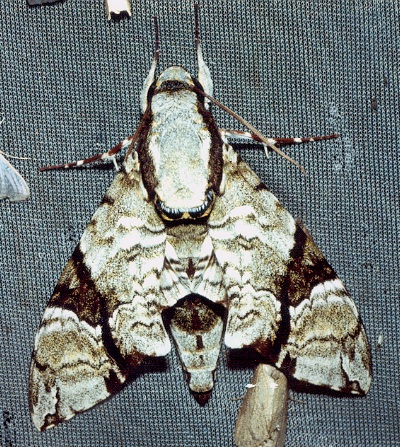
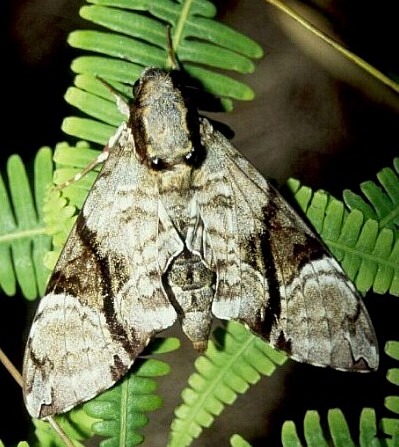
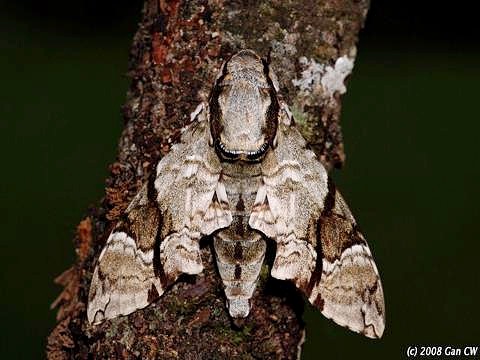
China: 8.iii (Hainan); 7.iv (Hainan); 23-31.v (Hainan); 9.vi (Yunnan); 27.vi (Yunnan); vii (Henan); 27-31.vii (Hainan); viii (Hainan); 9.viii (Yunnan).
OVUM: Unknown.
LARVA: Dvořák (2016) illustrates a larva which is claimed to be of this species, even though it was never reared through to the adult stage. With the discovery of the early stages of Megacorma obliqua in China it is obvious that the larva illustrated and described by Dvořák (2016) is of another, unknown species.
In the fourth instar body elongate and of equal thickness along its length. Head and basic body colour apple-green, with seven broad, white, oblique lateral stripes, with that below the horn widened into a pale, tiangular patch. Several canary-yellow, crest-like tubercles adorn the dorsal surface of the thoracic segments. A jointed dorsal line of the same colour snakes down towards the large, tubercled, sinusoidal green horn, which is held horizontal, similar to that of Acherontia styx (Westwood, 1847). Body laterally and ventrally with sparse white tubercles in the green areas. Head with pale cheek stripes. The true legs pink.
The final instar is remarkably different, with the whole larva mimicking a lichen and algae-covered broken twig. Body still elongate and of equal thickness, with thoracic thorn-like tubercles and a horizontal, sinusoidal horn. However, the body is now various shades of silver and brownish-grey, with small brown markings mimicking cracks in the immitation bark-like skin. Diffuse greenish and darker grey areas mimic patches of algae and lichen. The thoracic segments are brownish-buff surrounded by a brown edge, which resembles the end of a broken twig. The pale area below the horn is of a similar colour. The horn is buff-coloured, almost brownish-cream.
PUPA: Colour a rich, glossy, mahogany\leather brown, with a large, distinctive, 'jug-handle' tongue case. In other words, similar to that of Agrius convolvuli (Linnaeus, 1758), but more elongate and with a considerably longer tongue case, which initially projects frontad and then loops around and terminates in a bulb at the base of the leg area.
Larval hostplants. Reputed to be Spathodea campanulata and Oroxylum indicum (Bignoniaceae) in the Philippines (Dvořák, 2016). However, with the discovery of the early stages of Megacorma obliqua in China it is obvious that the hostplants described by Dvořák (2016) are for another, unknown species.
China: Henan (Mt. Niuxinduo, Luanchuan, 1763m); Yunnan (Pingbian County, Dawei Shan Nature Reserve, 2000m; Yinjiang; Gaoligong Shan; Menglun Botanical Garden, Xishuangbanna; Simao/Pu'er; Menglunzhen; Bubengcun); Hainan (Changjiang Li Autonomous County; Diaoluo Shan National Forest Park; Mingfeng Valley; Jianfengling National Forest Park; Yajia Daling; Yinggeling Yinggezui Substation).
Sri Lanka, south-western India (Karnataka), north-eastern India, Burma/Myanmar, south-western China (Henan, Yunnan, Hainan), Thailand, central Vietnam (Le & Vu, 2024), Malaysia (Peninsular, Sarawak, Sabah), Indonesia (Sumatra, Kalimantan, Java, Ceram, Papua Barat), Philippines (including Palawan) (Inoue, 1996), Papua New Guinea, Solomon Islands.
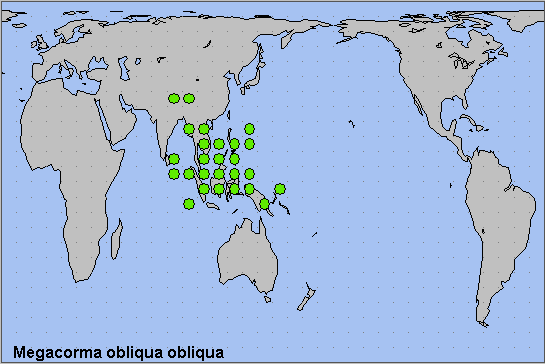
 Return to Sphingidae of the Eastern Palaearctic species list
Return to Sphingidae of the Eastern Palaearctic species list